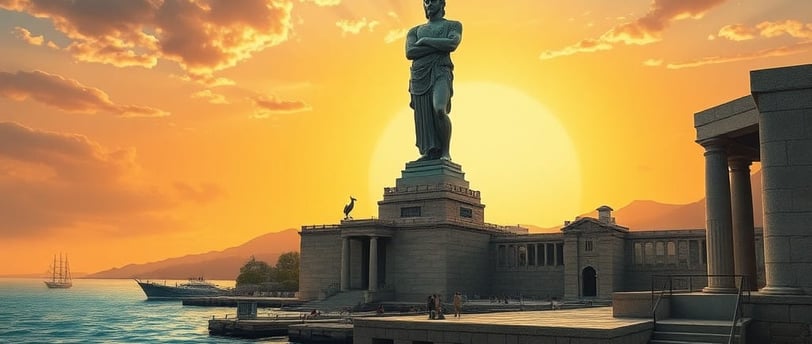The Colossus of Rhodes: A Wonder of the Ancient World
A bronze statue so magnificent it became one of the Seven Wonders of the Ancient World
HISTORICAL MYSTERIES
1/23/20253 min read


In the sunlit harbour of ancient Rhodes, there once stood a giant—a bronze statue so magnificent it became one of the Seven Wonders of the Ancient World. The Colossus of Rhodes, a tribute to the sun god Helios, was not just a monument; it was a testament to human ingenuity, determination, and the enduring spirit of a people who overcame adversity. Though it stood for only a short time, its legacy has endured for millennia, captivating the imagination of historians, artists, and travellers alike.
A Triumph of Victory
The story of the Colossus begins in 305 BCE, when the people of Rhodes successfully defended their island from a year-long siege by Demetrius I of Macedon. In celebration of their victory, the Rhodians decided to honour Helios, their patron deity, by constructing a monumental statue. The task of designing and building this colossal tribute was entrusted to Chares of Lindos, a renowned sculptor and student of Lysippos, the famed artist of Alexander the Great’s likeness.
The Construction: A Marvel of Engineering
The Colossus was no ordinary statue. Standing approximately 33 meters (108 feet) tall, it was one of the tallest statues of the ancient world. To construct such a masterpiece, Chares employed innovative techniques. The internal structure was built with an iron and stone framework to provide stability, while the outer layers were crafted from bronze plates, likely repurposed from weapons left behind by Demetrius’ army. The bronze was meticulously hammered and shaped, then riveted to the framework to create the statue’s shimmering surface.
The statue’s construction took 12 years to complete, with workers labouring tirelessly under the Mediterranean sun. While artistic depictions often show the Colossus straddling the harbour entrance, this image is likely a later romanticized interpretation. Most historians believe the statue stood on a solid base near the harbour, towering over the city as a symbol of strength and unity.
A Brief Glory
When the Colossus was completed in 280 BCE, it became an immediate source of pride for the Rhodians. The statue’s towering presence was visible to sailors approaching the island, serving as both a beacon and a declaration of Rhodes’ resilience. Its gleaming bronze surface reflected the sunlight, symbolizing Helios’ protection over the island and its people.
The Earthquake and Tragic Fall
The Colossus’ reign as a wonder of the world was tragically short-lived. In 226 BCE, just 54 years after its completion, a devastating earthquake struck Rhodes. The statue’s knees and lower legs, unable to withstand the tremors, buckled, causing the mighty figure to collapse. The fallen pieces lay scattered across the harbour, but even in ruin, the Colossus inspired awe. Ancient historians like Pliny the Elder wrote that the remains of the statue were so massive that few people could wrap their arms around its fallen thumb.
The Rhodians, devastated by the loss, sought guidance from the Oracle of Delphi, who advised against rebuilding the statue. Believing it to be a sign of Helios’ displeasure, they left the ruins untouched for nearly 800 years. The broken Colossus remained a tourist attraction in its own right, drawing visitors from across the ancient world.
The Legacy of the Colossus
In 654 CE, the remains of the Colossus were reportedly sold to Arab invaders, who melted down the bronze for reuse. According to legend, the scrap metal required 900 camels to transport, marking the end of the statue’s physical existence. Yet, its memory persisted, inspiring countless artists, writers, and architects through the centuries.
Today, the Colossus of Rhodes lives on in popular imagination. It has influenced modern monuments like the Statue of Liberty, often seen as a spiritual successor to the ancient wonder. In Rhodes, the harbour where the Colossus once stood is still a bustling site, with visitors marvelling at the thought of such a colossal figure gracing the skyline.
Who Was Chares of Lindos?
Though little is known about Chares, his vision and ambition in creating the Colossus cemented his place in history. Some speculate that his work was inspired by his teacher Lysippos, who was known for pushing the boundaries of scale and proportion in sculpture. Chares’ engineering skills and artistic mastery remain a testament to the ingenuity of ancient Greek craftsmen.
How Did It Feel to Witness Its Fall?
For the people of Rhodes, the fall of the Colossus must have been devastating. It was not just a statue but a symbol of their triumph and identity. To see it lying in ruins, shattered by forces beyond their control, likely felt like losing a piece of their soul. Yet, their decision to leave the ruins as they were shows a profound respect for its legacy, even in destruction.
The Colossus in Modern Times
Efforts have been proposed to rebuild the Colossus in modern times, but none have come to fruition. Still, the idea of reconstructing the statue continues to spark debate and fascination. Whether it remains a memory or is reborn as a modern wonder, the Colossus of Rhodes will always stand as a symbol of human ambition and the impermanence of greatness.
Did you like this article?
Thank you for your support!
Every donation helps us create more engaging content, improve the quality of our stories, and dive deeper into the fascinating worlds of ancient legends, historical mysteries, and folklore. Your contribution fuels our creativity and allows us to share these captivating tales with a wider audience.
Together, we can bring these myths and stories to life! 🙏✨
© 2025. All rights reserved.
You may notice "Buy Me a Coffee" links throughout this site. These links allow readers to support our work and help us maintain this platform. By relying on contributions from our audience, we aim to avoid intrusive advertisements, ensuring a cleaner and more enjoyable reading experience for you.
Your support keeps our site ad-free and helps us continue sharing stories, mysteries, and insights without distractions. Thank you for being part of our journey!
